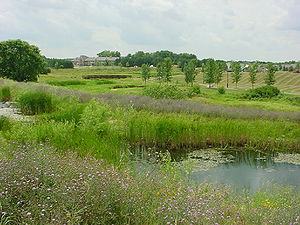
Green Infrastructure benefits of constructed wetlands
This site is currently undergoing revision. For more information, open this link.
This page is in development
This page is in development
Stormwater wetlands are similar in design to stormwater ponds and mainly differ by their variety of water depths and associated vegetative complex. They require slightly more surface area than stormwater ponds for the same contributing drainage area. Stormwater wetlands are constructed stormwater management practices, not natural wetlands. Like ponds, they can contain a permanent pool and temporary storage for water quality control and runoff quantity control.
Contents
Green Infrastructure benefits of constructed wetlands
| Benefit | Effectiveness | Notes |
|---|---|---|
| Water quality | Primary benefit is retention of sediment; may export phosphorus if not designed and maintained properly. | |
| Water quantity/supply | Rate control benefit. | |
| Energy savings | ||
| Climate resiliency | Provides some rate control. Impacts on carbon sequestration are uncertain. | |
| Air quality | ||
| Habitat improvement | Use of perennial vegetation and certain media mixes promote invertebrate communities. | |
| Community livability | Aesthetically pleasing and can be incorporated into a wide range of land use settings. | |
| Health benefits | ||
| Economic savings | Generally provide cost savings vs. conventional practices over the life of the practice. | |
| Macroscale benefits | Individual practices are typically microscale, but multiple practices, when incorporated into a landscape design, provide macroscale benefits such as wildlife corridors. | |
| Level of benefit: ◯ - none; ◔ - small; ◑ - moderate; ◕ - large; ● - very high | ||
- Water quality: Pollutants are removed from stormwater runoff in a wetland through uptake by wetland vegetation and biota (algae, bacterial), vegetative filtering, soil adsorption, and gravitational settling in the slow moving marsh flow. Volatilization and chemical activity can also occur, breaking down and assimilating a number of other stormwater contaminants such as hydrocarbons. Wetlands effectively remove solids and pollutants associated with solids. They are only moderately effective at removing nitrogen and phosphorus. Some designs or poorly designed and maintained wetlands may export phosphorus.
- Water quantity and hydrology: Stormwater wetlands temporarily store water and therefore effectively control runoff rates. They are well-suited to provide channel protection and overbank flood protection. This is accomplished with live storage (extended detention) above the permanent pool. Properly designed wetlands do not contribute significantly to infiltration.
- Climate resiliency: Wetlands improve ecosystem services, alleviate water shortages through water re-use, and provide flood control. Rates of carbon accumulation measured in the soils of other constructed wetlands suggest that these systems provide sequestration benefits.
- Habitat improvement: Constructed wetlands, because they retain a permanent water pool, provide excellent wildlife habitat. Many wildlife species are dependent on or otherwise utilize wetland habitats, including waterfowl, wading birds, shorebirds and songbirds, furbearers such as beaver, muskrat and mink, and a variety of reptiles and amphibians like turtles, snakes, frogs, salamanders, and toads. An important factor affecting the habitat value of a constructed wetland is the surrounding landscape. A complex of wetland types interspersed with upland nesting cover provides optimum habitat. Isolated wetlands provide significantly habitat value. (References: [1]; [2]; [3]; [4]; [5])
- Community livability: Constructed ponds are an aesthetically pleasing practice. However, they require space and are difficult to incorporate in urban landscapes. A variety of vegetation can also be used, including perennial plants, shrubs, and trees.
- Health benefits: Green spaces may also improve mental and physical health for residents and reduce crime (Barton and Rogerson, 2017).
- Economic savings: Properly designed and integrated constructed wetland practices provide life cycle cost savings. Well designed and maintained constructed wetland practices increase property values.
Design considerations
Maximizing specific green infrastructure (GI) benefits of bioretention practices requires design considerations prior to constructing the practice. While site limitations cannot always be overcome, the following recommendations maximize the GI benefit of bioretetnion.
- Water quality
- Water quantity/supply
- Climate resiliency
- Moore and Hunt (2012) determined that most carbon accumulated in constructed wetlands was autochthonous (derived in situ rather than imported). Thus, vegetation establishment is critical to carbon sequestration, with dense emergent communities being favored. Ensure water levels are shallow enough to support emergent macrophytes. Adjustable outlet structures and proper construction and maintenance are tools for ensuring shallow water levels that favor emergent vegetation.
- To avoid or minimize the potential for methane release, properly maintain wetlands.
- Habitat
- Include a littoral shelf that promotes emergent macrophytes (Moore and Hunt, 2012)
- Vegetative biodiversity may be enhanced by planting littoral areas rather than relying upon natural colonization.
- Promote a diversity of predators to control mosquito populations (Greenway, 2010.)
- Community livability
- Health benefits
- Economic benefits
Recommended reading
References
- Moore, T.L.C., W.F. Hunt. 2012. Ecosystem service provision by stormwater wetlands and ponds e A means for evaluation?. Water Research. 46:6811-6823.
